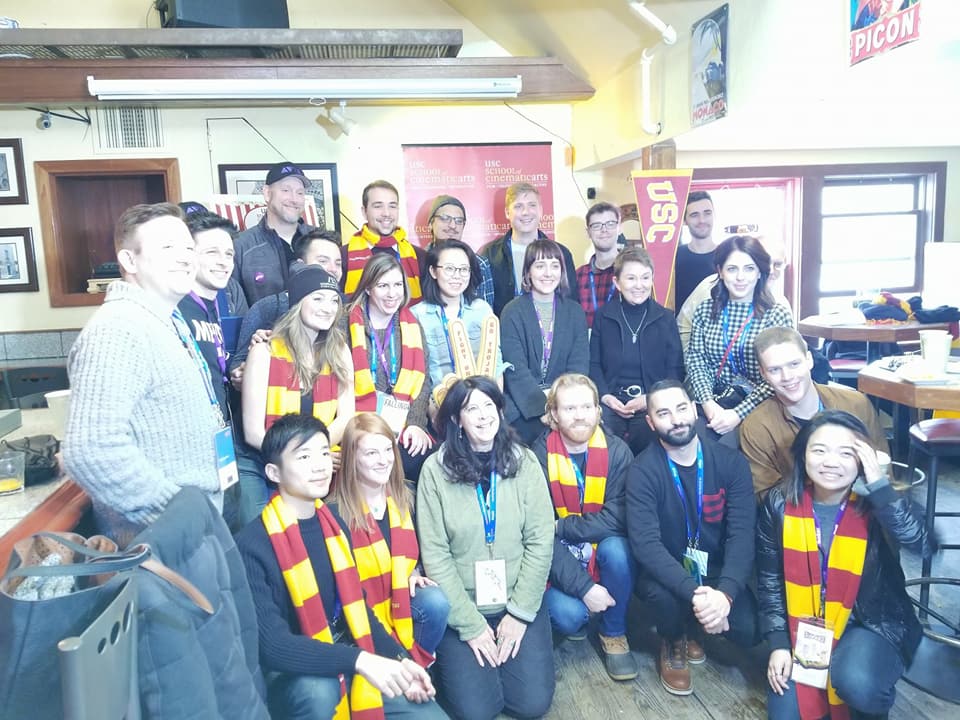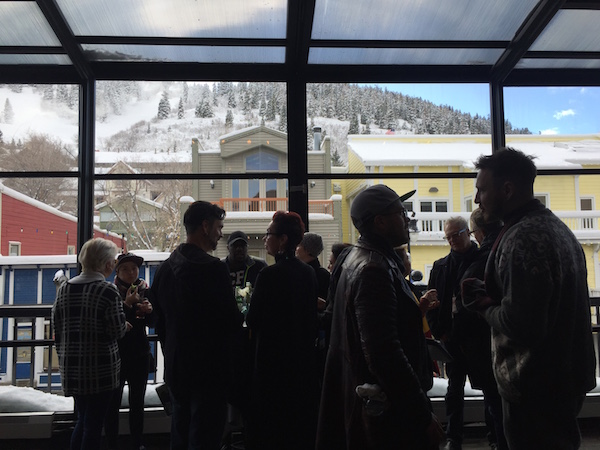Ewen Wright and Sara Fenton
The short film is the bread and butter of the graduating film student. It’s a calling card. It’s a work of art. It’s an incredible amount of work.
This year, alumni Sara Fenton ’17 and Ewen Wright ’17 hit pay dirt with their narrative short FALLING which was honored with a screening of the Slamdance Film Festival They answered five quick questions about Sundance for their alma mater. They are below.
FALLING – 19 min – Narrative Short | Official Selection – Slamdance 2018
How did you come up with the idea for it and what message do you hope it conveys?
Ewen: This started as a writing project that I didn’t intend to make. For that reason I was unconcerned with production logistics and it became a project that was more of a cathartic exercise and an expression of many things I felt were insane in our society. I was representing these things using metaphor and was playing with what would happen to make those metaphors come back into the literal. So many elements and characters came to life in a very absurd and surreal world.
In terms of the message that it conveys the intention was always for this piece to provoke questions and conversations rather than provide easy answers. It’s taking on many issues and centers around questions of race and gender, and I certainly don’t have clear solutions to the problems within, so I wanted to express that in a way that would be meaningful, entertaining, and thought provoking all at once.
Sara: I like to describe this film as a comedy about racism, sexism, privilege and police brutality – because those things are hilarious, right? The tendency for social change films is to be heavy handed and serious and treat issues with reverence and gravitas. While there is definitely a time and place for that, I’ve always believed in laughing your way through difficult conversations. I don’t advocate trivializing or making light of serious issues, but believe humor is a way of revealing truth and easing into what can sometimes be fraught conversations.
What were some challenges you had in bringing your vision to life?
Ewen: As I mentioned, I didn’t actually think I would ever produce this piece when I wrote it. However, once it was on the page it really became an exciting prospect. This did mean that we needed to figure out a bunch of production hurdles including a different location every day, stunts, weapons, street closures, visual effects, vehicles, and lots of background actors.
Sara: When Ewen and our co-producer Rachel approached me with a script containing children, weapons, police violence, racial tensions, moving vehicles, street closures, overnights and a large ensemble cast, it seemed impossible to put all those things into a student film. But even as we talked about simplifying, scaling down, and re-working the script, we also kept asking for help, pulling favors, and believing in miracles. What you see on the screen is the result of a lot of people believing in a scrappy can-do group of students. Including all those elements could have been prohibitively expensive if we hadn’t had all the USC resources at our fingertips and the generosity of family and friends.
For the big crowd scenes and police officer interactions, we worked with Film LA on a closed street downtown and one overnight on the CBS Backlot. You may recognize the restroom at Town and Gown on campus. We got a great package deal on the cop cars and SWAT gear including uniforms and guidance from a former police officer. Pretty much everyone we know has a background role in this film!
What’s it like to have your project be in one of the world’s best known festivals?
Sara: The Guardian describes Slamdance as the “edgy, no frills sibling to Sundance”. I relate to that both personally and in terms of the content and tone of our film. We got to experience both festivals and it was nice to bounce back and forth between the larger, sleeker, excitement and hullabaloo of Sundance and the grassroots DIY feel of Slamdance. One evening we’d be celebrating in a heated tent, with a DJ and fancy appetizers and the next we’d be rubbing elbows with off beat filmmakers in what felt like a house party in your friends’ basement.
Maybe it’s my Fringe festival background, but my favorite part was creatively promoting our screening. One of the storylines in the film is a woman who self medicates to calm her emotional distress so, we had customized Falling M&M “happy pills” in dime baggies with our screening information. We distributed hand-warmers & toe-warmers with one of the quotes from our film “here: this will help” and went out daily with a staple gun to participate in the unregulated “poster wars” in the designated promotion areas (pictured).
It was great to have brunch with Dean Daley and connect with other alumni at the festival in the events organized by USC industry relations.
Ewen: We’re in Slamdance, which is a great fit for this project. The piece is a bit edgier in both content and form, and the support and reception at the festival has been really meaningful and rewarding. I can’t think of a better premiere home for it, and the experience in Park City has been deeply inspiring and a blast.
How did your USC experience help you in creating this work?
Ewen: This was a 581 Thesis – almost all of the key crew was made up of USC students either in the MFA program with us, or undergrads we’d SA’d for, or connections to those people. I want to give a shoutout to Brenda Goodman who is an incredible ally to the thesis program and all of her students and made this project feel doable despite its ambitions. Everett Lewis, Barnett Kellman and Michael Uno, none of who were direct mentors of this project, all gave me tools and advice that were constantly resonating in my mind through this process.
Sara: Michael Taylor from the Media Institute for Social Chance was our faculty mentor. Torrie Rozensweig & Ari Sandel, my Organizing Creativity profs helped prime me for the festival experience and gave me pre-Sun/Slamdance pep talks (ask Ari about his West Bank Story experience). As much as we may grumble about doing hazardous shooting forms and rules and restrictions at USC, that framework of conscientious filmmaking allowed us to pull off some riskier shooting conditions knowing we’d done everything to ensure the safety and well being of our cast and crew. Thanks Joe Wallenstein!
info & links:
Ewen Wright’s Website www.coolcatproductions.com
Instagram @you_n_ewen
Sara Fenton’s Website www.sarafenton.com
Instagram @fentonova
Fallling Website www. youreactingcrazy.com
Instagram @fallingthefilm
Slamdance www.slamdance.com
Instagram @slamogram




















